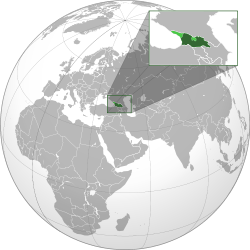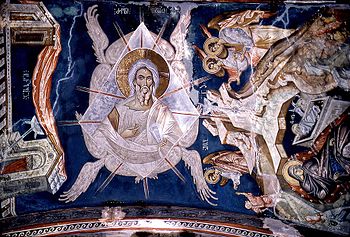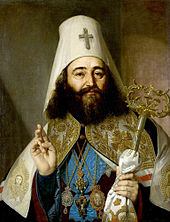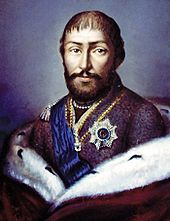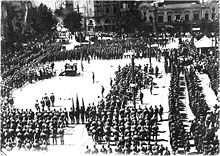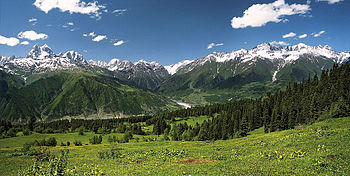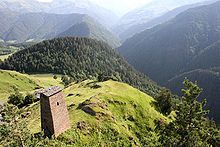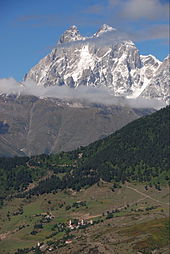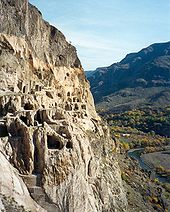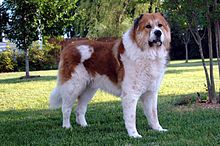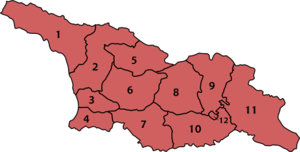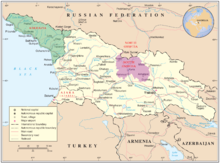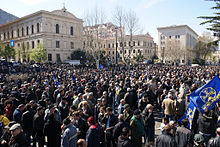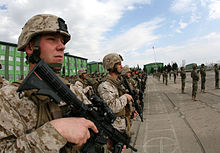
Georgia (country)
About this schools Wikipedia selection
This selection is made for schools by a children's charity read more. SOS Children works in 45 African countries; can you help a child in Africa?
| Georgia საქართველო
Sakartvelo |
||||||
|---|---|---|---|---|---|---|
|
||||||
| Motto: ძალა ერთობაშია "Dzala ertobashia" "Strength is in Unity" |
||||||
| Anthem: თავისუფლება Tavisupleba Freedom |
||||||
|
Georgia proper shown in dark green; areas outside of Georgian control shown in light green.
|
||||||
| Capital |
41°43′N 44°47′E |
|||||
| Largest city | Tbilisi | |||||
| Official languages | Georgian | |||||
| Spoken languages | 71% Georgian 9% Russian 7% Armenian 6% Azeri 7% other |
|||||
| Ethnic groups (2002) | 83.8% Georgian 6.5% Azeri 5.7% Armenian 1.5% Russian 2.5% others |
|||||
| Demonym | Georgian | |||||
| Government | Unitary semi-presidential republic | |||||
| - | President | Mikheil Saakashvili | ||||
| - | Prime Minister | Bidzina Ivanishvili | ||||
| Legislature | Parliament | |||||
| Independence | ||||||
| - | from Russian Empire | May 26, 1918 | ||||
| - | Soviet re-conquest | February 25, 1921 | ||||
| - | from Soviet Union Declared
Finalized |
April 9, 1991 December 25, 1991 |
||||
| Area | ||||||
| - | Total | 69,700 km2 ( 120th) 26,911 sq mi |
||||
| Population | ||||||
| - | 2011 estimate | 4,469,200 ( 121st) | ||||
| - | Density | 68.1/km2 ( 144th) 164.2/sq mi |
||||
| GDP ( PPP) | 2012 estimate | |||||
| - | Total | $26.348 billion | ||||
| - | Per capita | $5,929 | ||||
| GDP (nominal) | 2012 estimate | |||||
| - | Total | 15.984 billion | ||||
| - | Per capita | $3,597 | ||||
| Gini (2010) | 42.1 medium |
|||||
| HDI (2012) | high · 72th |
|||||
| Currency | Lari (ლ) ( GEL) |
|||||
| Time zone | GET ( UTC +4) | |||||
| - | Summer ( DST) | not observed ( UTC +4) | ||||
| Drives on the | right | |||||
| Calling code | +995 | |||||
| ISO 3166 code | GE | |||||
| Internet TLD | .ge | |||||
Georgia / ˈ dʒ ɔr dʒ ə / ( Georgian: საქართველო Sakartvelo, IPA: [sɑkʰɑrtʰvɛlɔ]) is a sovereign state in the Caucasus region of Eurasia. Located on the coast of the Black Sea, it is bounded to the north and northeast by Russia, to the south by Turkey and Armenia, and to the southeast by Azerbaijan. A unitary, semi-presidential republic, Georgia covers a territory of 69,700 km² with a population of almost 4.5 million.
During the classical era, independent kingdoms became established in what is now Georgia. The most important of these interrelated kingdoms, Colchis and Iberia, adopted Christianity in the early 4th century and converged into a single state by 9th century. A unified Georgia reached the peak of its strength beginning with the reign of King David IV, who inaugurated the Georgian Golden Age, a period of military, economic, and cultural expansion that lasted through the reign of Queen Tamar. By 15th century invasions from neighbouring countries caused Georgia to disintegrate into separate kingdoms and principalities, remaining so until 1801, when the country was gradually annexed by the Russian Empire. After a brief period of independence following the Russian Revolution of 1917, Georgia was occupied by Soviet Russia in 1921, becoming the Georgian Soviet Socialist Republic and part of the Soviet Union. After independence in 1991, post-communist Georgia suffered from civil unrest and economic crisis for most of the 1990s. This lasted until the Rose Revolution of 2003, after which the new government introduced democratic and economic reforms.
Georgia is a member of the Council of Europe, while aspiring to join NATO and the European Union. It contains two de facto independent regions, Abkhazia and South Ossetia, both of which gained only limited international recognition after the 2008 Russo-Georgian War. Georgia considers the regions to be part of its sovereign territory under Russian military occupation.
Name
"Georgia" is an exonym, used in the West since the medieval period, exact origin of which is unclear. The name was first etymologized as referring to St. George, Georgia's patron saint, in the 12th century by Jacques de Vitry, who had remarked Georgians' special reverence for that saint during their expeditions to the Holy Land. Alternatively, Jean Chardin semantically linked "Georgia" to Greek and Latin roots, respectively, γεωργός ("tiller of the land") and georgicus ("agricultural"). The supporters of this explanation sometimes referred to classical authors Pliny and Pomponius Mela, who used the name to distinguish agricultural societies from their unsettled and pastoral neighbors, as was the case with Georgia. The Russian and Russian-based exonyms for Georgia trace their roots to the Persian designation of the Georgians, gurğ, ğurğ, borrowed around the time of the First Crusade, ultimately derived from a Middle Persian varkâna, meaning "land of wolves" - this reflects the wolf cult in ancient Georgia.
The self-designation used by ethnic Georgians is Kartvelebi (ქართველები, i.e. " Kartvelians"), the native name of Georgia Sakartvelo ( საქართველო "land of Kartvelians" and of the Georgian language Kartuli (ქართული). The medieval Georgian Chronicles present an eponymous ancestor of the Kartvelians, Kartlos, a great-grandson of Japheth. The name Sakartvelo (საქართველო) consists of two parts. Its root, kartvel-i (ქართველ-ი), specifies an inhabitant of the core central-eastern Georgian region of Kartli, or Iberia as it is known in sources of Eastern Roman Empire. Ancient Greeks ( Strabo, Herodotus, Plutarch, Homer, etc.) and Romans ( Titus Livius, Tacitus, etc.) referred to early western Georgians as Colchians and eastern Georgians as Iberians (Iberoi in some Greek sources).
History
Prehistory
The territory of modern-day Georgia has been inhabited by Homo erectus since the Paleolithic Era. The proto-Georgian tribes first appear in written history in the 12th century BC. Archaeological finds and references in ancient sources reveal elements of early political and state formations characterized by advanced metallurgy and goldsmith techniques that date back to the 7th century BC and beyond.
Antiquity
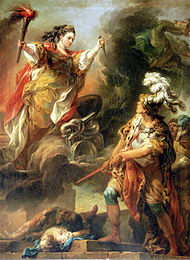
The classic period saw the rise of several early Georgian states, the most important of which were known to Greco-Roman historiography as Colchis ( Georgian: კოლხეთი) (in what is now western Georgia) and Iberia ( Georgian: იბერია) (in what is now eastern Georgia). Following centuries of flourishing, the kingdoms gradually fell to the Roman Empire by 66 BC, with with western Georgia becoming for a long period and integral part of the empire, and eastern Georgia remaining a Roman client state and ally for nearly 400 years.
In 337 AD King Mirian III declared Christianity as the state religion, giving a great stimulus to the development of literature, arts, and ultimately playing a key role in the formation of the unified Georgian nation. Mirian's acceptance of Christianity effectively tied his kingdom and its successor states to the neighboring Eastern Roman Empire, which exerted strong influence on Georgia for nearly a millennium, determining much of its present cultural identity.
In Greek mythology, Colchis was the location of the Golden Fleece sought by Jason and the Argonauts in Apollonius Rhodius' epic tale Argonautica. The incorporation of the Golden Fleece into the myth may have derived from the local practice of using fleeces to sift gold dust from rivers. Known to its natives as Egrisi or Lazica, Colchis was also the battlefield of the 20-year Lazic War, which ended with relative victory of the Byzantine Empire over Persia, with Constantinople maintaining its longstanding hegemony in the area.
Middle Ages
The early kingdoms disintegrated into various feudal regions by the early Middle Ages. This made it easy for Arabs to conquer southern parts of eastern Georgia in the 7th century. Although Arabs captured the capital city of Tbilisi in AD 645, Kartli-Iberia retained considerable independence under local Arab rulers. In AD 813 the prince Ashot I – also known as Ashot Kurapalat – became the first of the Bagrationi family to rule the kingdom. Ashot's reign began a period of nearly 1,000 years during which the Bagrationi, as the house was known, ruled at least part of what is now the republic. Bagrat III (r. 1027–72) united western and eastern Georgia.
The Georgian Kingdom reached its Golden Age in the 12th to early 13th centuries. This period has been widely termed as Georgia's Golden Age or Georgian Renaissance during the reigns of David the Builder and Queen Tamar, the first woman to rule the country in her own right This early Georgian renaissance, which preceded its West European analogue, was characterized by the flourishing of romantic-chivalric tradition, breakthroughs in philosophy, and an array of political innovations in society and state organization, including religious and ethnic tolerance.
The Golden age of Georgia left a legacy of great cathedrals, romantic poetry and literature, and the epic poem " The Knight in the Panther's Skin". David the Builder is popularly considered to be the greatest and most successful Georgian ruler in history. He succeeded in driving the Seljuks out of the country, winning the major Battle of Didgori in 1121. To highlight his country's higher status, David IV became the first Georgian king to reject the highly respected titles bestowed by the Eastern Roman Empire, Georgia’s longtime ally, indicating that Georgia would deal with its powerful friend only on a parity basis. Due to close family ties between Georgian and Byzantine royalty - Princess Martha of Georgia, aunt of David IV, was once a Byzantine Empress Consort - by 11th century as many as 16 Georgian ruling princes and kings had held Byzantine titles, David becoming the last one to do so.
David the Builder's granddaughter Tamar succeeded in neutralizing opposition and embarked on an energetic foreign policy aided by the downfall of the rival powers of the Seljuks and Byzantium. Supported by a powerful military élite, Tamar was able to build on the successes of her predecessors to consolidate an empire which dominated the Caucasus, and extended over large parts of present-day Azerbaijan, Armenia, and eastern Turkey, until its collapse under the Mongol attacks within two decades after Tamar's death.
The revival of the Georgian Kingdom was set back after Tbilisi was captured and destroyed by the Khwarezmian leader Jalal ad-Din in 1226. The Mongols were expelled by George V of Georgia, son of Demetrius II of Georgia, who was named "Brilliant" for his role in restoring the country's previous strength and Christian culture. George V was the last great king of the unified Georgian state. After his death, different local rulers fought for their independence from central Georgian rule, until the total disintegration of the Kingdom in the 15th century. Georgia was further weakened by several disastrous invasions by Tamerlane. Invasions continued, giving the Kingdom no time for restoration, with both Black and White sheep Turkomans constantly raiding its southern provinces. As a result, Georgian Kingdom collapsed into anarchy by 1466 and fragmented into three independent Kingdoms and five semi-independent principalities. Neighboring empires exploited the internal division of the weakened country, and beginning in the 16th century, the Persian Empire and the Ottoman Empire subjugated the eastern and western regions of Georgia, respectively.
The rulers of regions which remained partly autonomous organized rebellions on various occasions. However, subsequent Persian and Ottoman invasions further weakened local kingdoms and regions. As a result of incessant wars the population of Georgia dwindled from 5 million in the 13th century to 250,000 inhabitants at the end of the 18th century. Eastern Georgia, composed of the regions of Kartli and Kakheti, had been under Persian suzerainty since 1555. With the death of Nader Shah in 1747, both kingdoms broke free of Persian control and were reunified through a personal union under the energetic king Heraclius II in 1762.
Georgia in the Russian Empire
In 1783, Russia and the eastern Georgian Kingdom of Kartli-Kakheti signed the Treaty of Georgievsk, which recognized the bond of Orthodox Christianity between Russian and Georgian people and promised eastern Georgia protection. However, despite this commitment to defend Georgia, Russia rendered no assistance when the Turks and Persians invaded in 1785 and in 1795, completely devastating Tbilisi and massacring its inhabitants. This period culminated in the 1801 Russian violation of the Treaty of Georgievsk and annexation of eastern Georgia, followed by the abolishment of the royal Bagrationi dynasty, as well as the autocephaly of the Georgian Orthodox Church. Pyotr Bagration, one of the descendants of the abolished house of Bagrationi would later join the Russian army and rise to be a general by the Napoleonic wars.
On December 22, 1800, Tsar Paul I of Russia, at the alleged request of the Georgian King George XII, signed the proclamation on the incorporation of Georgia (Kartli-Kakheti) within the Russian Empire, which was finalized by a decree on January 8, 1801, and confirmed by Tsar Alexander I on September 12, 1801. The Georgian envoy in Saint Petersburg reacted with a note of protest that was presented to the Russian vice-chancellor Prince Kurakin. In May 1801, under the oversight of General Carl Heinrich Knorring Imperial Russia transferred power in eastern Georgia to the government headed by General Ivan Petrovich Lasarev. The Georgian nobility did not accept the decree until April 1802 when General Knorring compassed the nobility in Tbilisi's Sioni Cathedral and forced them to take an oath on the Imperial Crown of Russia. Those who disagreed were temporarily arrested.
In the summer of 1805, Russian troops on the Askerani River near Zagam defeated the Persian army and saved Tbilisi from conquest now that it was officially part of the Imperial territories. Following the annexation of eastern Georgia, the western Georgian kingdom of Imereti was annexed by Tsar Alexander I of Russia. The last Imeretian king and the last Georgian Bagrationi ruler Solomon II died in exile in 1815. From 1803 to 1878, as a result of numerous Russian wars against the Ottoman Empire, several of Georgia's previously lost territories – such as Adjara – were recovered. The principality of Guria was abolished and incorporated into the Empire in 1828, and that of Megrelia in 1857. The region of Svaneti was gradually annexed in 1857–59.
Declaration of independence
After the Russian Revolution of 1917, Georgia declared independence on May 26, 1918, in the midst of the Russian Civil War. The parliamentary election was won by the Menshevik Georgian Social-Democratic Party. Its leader, Noe Zhordania, became prime minister.
In 1918, the Georgian–Armenian War erupted over parts of Georgian provinces populated mostly by Armenians which ended because of British intervention. In 1918–19, Georgian general Giorgi Mazniashvili led a Georgian attack against the White Army led by Moiseev and Denikin in order to claim the Black Sea coastline from Tuapse to Sochi and Adler for independent Georgia. The country's independence did not last long. Georgia was under British protection from 1918–1920.
Georgia in the Soviet Union
In February 1921, Georgia was attacked by the Red Army. The Georgian army was defeated and the Social-Democrat government fled the country. On February 25, 1921 the Red Army entered the capital Tbilisi and installed a Moscow directed communist government, led by Georgian Bolshevik Filipp Makharadze.
Nevertheless the Soviet rule was firmly established only after a 1924 revolt was brutally suppressed. Georgia was incorporated into the Transcaucasian SFSR uniting Georgia, Armenia and Azerbaijan. The TSFSR was disaggregated into its component elements in 1936 and Georgia became the Georgian SSR.
Joseph Stalin, an ethnic Georgian, was prominent among the Bolsheviks, who came to power in the Russian Empire after the October Revolution in 1917. Stalin was to rise to the highest position of the Soviet state.
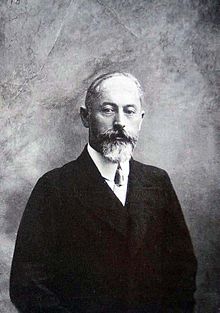
From 1941 to 1945, during World War II, almost 700,000 Georgians fought in the Red Army against Nazi Germany. (A number also fought on the German side.) About 350,000 Georgians died in the battlefields of the Eastern Front.
On April 9, 1989, a peaceful demonstration in the Georgian capital Tbilisi ended up with several people being killed by Soviet troops. Before the October 1990 elections to the national assembly, the Umaghlesi Sabcho (Supreme Council) – the first polls in the USSR held on a formal multi-party basis – the political landscape was reshaped again. While the more radical groups boycotted the elections and convened an alternative forum (the National Congress) with alleged support of Moscow, another part of the anticommunist opposition united into the Round Table—Free Georgia around the former dissidents like Merab Kostava and Zviad Gamsakhurdia. The latter won the elections by a clear margin, with 155 out of 250 parliamentary seats, whereas the ruling Communist Party (CP) received only 64 seats. All other parties failed to get over the 5%-threshold and were thus allotted only some single-member constituency seats.
Georgia after restoration of independence
On April 9, 1991, shortly before the collapse of the Soviet Union, Georgia declared independence. On May 26, 1991, Zviad Gamsakhurdia was elected as a first President of independent Georgia. Gamsakhurdia stoked Georgian nationalism and vowed to assert Tbilisi's authority over regions such as Abkhazia and South Ossetia that had been classified as autonomous oblasts under the Soviet Union.
He was soon deposed in a bloody coup d'état, from December 22, 1991, to January 6, 1992. The coup was instigated by part of the National Guards and a paramilitary organization called " Mkhedrioni" or "horsemen". The country became embroiled in a bitter civil war which lasted almost until 1995. Eduard Shevardnadze returned to Georgia in 1992 and joined the leaders of the coup — Kitovani and Ioseliani — to head a triumvirate called "The State Council".
In 1995, Shevardnadze was officially elected as president of Georgia. At the same time, simmering disputes within two regions of Georgia, Abkhazia and South Ossetia, between local separatists and the majority Georgian populations, erupted into widespread inter-ethnic violence and wars. Supported by Russia, Abkhazia, and South Ossetia, with the exception of some "pockets" of territory, achieved de facto independence from Georgia.
Roughly 230,000 to 250,000 Georgians were expelled from Abkhazia by Abkhaz separatists and North Caucasian volunteers (including Chechens) in 1992–1993. Around 23,000 Georgians fled South Ossetia as well, and many Ossetian families were forced to abandon their homes in the Borjomi region and moved to Russia.
In 2003, Shevardnadze (who won reelection in 2000) was deposed by the Rose Revolution, after Georgian opposition and international monitors asserted that the November 2 parliamentary elections were marred by fraud. The revolution was led by Mikheil Saakashvili, Zurab Zhvania and Nino Burjanadze, former members and leaders of Shevardnadze's ruling party. Mikheil Saakashvili was elected as President of Georgia in 2004.
Following the Rose Revolution, a series of reforms were launched to strengthen the country's military and economic capabilities. The new government's efforts to reassert Georgian authority in the southwestern autonomous republic of Ajaria led to a major crisis early in 2004. Success in Ajaria encouraged Saakashvili to intensify his efforts, but without success, in breakaway South Ossetia.
These events, along with accusations of Georgian involvement in the Second Chechen War, resulted in a severe deterioration of relations with Russia, fuelled also by Russia's open assistance and support to the two secessionist areas. Despite these increasingly difficult relations, in May 2005 Georgia and Russia reached a bilateral agreement by which Russian military bases (dating back to the Soviet era) in Batumi and Akhalkalaki were withdrawn. Russia withdrew all personnel and equipment from these sites by December 2007 while failing to withdraw from the Gudauta base in Abkhazia which it was required to vacate after the adoption of Adapted Conventional Armed Forces in Europe Treaty during the 1999 Istanbul summit.
The South Ossetia War and since
On August 7, 2008, Georgian forces began shelling the South Ossetian capital, Tskhinvali; this was followed, on August 8, 2008, by an advance of Georgian Army infantry, tanks, and police commandos into South Ossetia; the action was supported by artillery and air support, leading to the capture of a number of key South Ossetian towns and retreat of Russian peacekeepers and South Ossetian forces. However, after a Russian peacekeepers' base was shelled and personnel killed, units of the Russian 58th Army, supported by irregular forces, entered South Ossetia through the Roki Tunnel, thus leading to a three-day battle which left the city of Tskhinvali in ruins. Georgian forces were subsequently forced to retreat and the Russian Air Force began launching airstrikes against Georgian forces in South Ossetia, and multiple targets inside Georgia proper. The Georgian Air Force resisted and later continued to carry out air strikes against Russian troops. A second front was opened when the separatist Republic of Abkhazia, with Russian support, launched an offensive against Georgian troops in the Kodori Valley. Georgian troops offered minimal resistance and soon withdrew. Russian paratroopers launched raids against military bases in Senaki, Georgia, from Abkhazia, whilst the Russian Navy stationed a task force off the coast of Abkhazia, and sank a Georgian Coast Guard cutter.
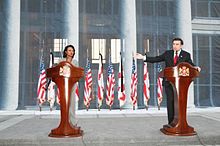
Russian forces, upon crossing into Georgia proper, soon entered Gori where Georgian forces had earlier regrouped before retreating to Tbilisi. Irregulars such as Ossetians, Chechens and Cossacks followed; looting, killing, and arson was reported. Russian troops removed military equipment abandoned by retreating Georgian troops in Gori and the port of Poti, where several naval and coast guard vessels moored in the harbour were scuttled.
On August 12, 2008, President Medvedev announced a halt to further Russian military operations in Georgia and ordered a gradual withdrawal from Gori, Poti and other established checkpoints. Despite this Russian forces remained in South Ossetia and Abkhazia, the independence of which it soon recognized.
Because of the intensive fighting in South Ossetia, there were many disputed reports about the number of casualties on both sides, which targets had fallen under aerial attacks, the status of troop movements, and the most current location of the front line between the Georgian and Russian-Ossetian units. Since the war, South Ossetian and Russian officials have made a number of unsubstantiated claims that the Georgian Army was responsible for killing 1,400–2,000 South Ossetian civilians. Human Rights Watch and European Union investigators in South Ossetia have subsequently accused Russia of exaggerating the scale of such casualties. All sides sustained casualties, with Georgia accounting for the greatest number of military casualties with 170 confirmed dead or missing.
Since the war, Georgia has maintained that Abkhazia and South Ossetia are under Russian occupation and remain, legally, part of Georgia. Georgia has gained much international support for this position although attempts at limiting international access to and enforcing an economic embargo of the two break-away regions have produced mixed results.
Geography and climate
Georgia is situated in the South Caucasus, between latitudes 41° and 44° N, and longitudes 40° and 47° E, with an area of 67,900 km2 (26,216 sq mi). It is a very mountainous country. The Likhi Range divides the country into eastern and western halves. Historically, the western portion of Georgia was known as Colchis while the eastern plateau was called Iberia. Because of a complex geographic setting, mountains also isolate the northern region of Svaneti from the rest of Georgia.
The Greater Caucasus Mountain Range forms the northern border of Georgia. The main roads through the mountain range into Russian territory lead through the Roki Tunnel between South and North Ossetia and the Darial Gorge (in the Georgian region of Khevi). The Roki Tunnel was vital for the Russian military in the 2008 South Ossetia war because it is the only direct route through the Caucasus Mountains. The southern portion of the country is bounded by the Lesser Caucasus Mountains. The Greater Caucasus Mountain Range is much higher in elevation than the Lesser Caucasus Mountains, with the highest peaks rising more than 5,000 meters (16,404 ft) above sea level.
The highest mountain in Georgia is Mount Shkhara at 5,068 meters (16,627 ft), and the second highest is Mount Janga ( Dzhangi-Tau) at 5,059 m (16,598 ft)above sea level. Other prominent peaks include Mount Kazbek) at 5,047 m (16,558 ft), Shota Rustaveli (4,860 m (15,945 ft), Tetnuldi (4,858 m (15,938 ft), Mt. Ushba (4,700 m (15,420 ft), and Ailama (4,547 m (14,918 ft). Out of the abovementioned peaks, only Kazbek is of volcanic origin. The region between Kazbek and Shkhara (a distance of about 200 km (124 mi) along the Main Caucasus Range) is dominated by numerous glaciers. Out of the 2,100 glaciers that exist in the Caucasus today, approximately 30% are located within Georgia.
The term Lesser Caucasus Mountains is often used to describe the mountainous (highland) areas of southern Georgia that are connected to the Greater Caucasus Mountain Range by the Likhi Range. The area can be split into two separate sub-regions; the Lesser Caucasus Mountains, which run parallel to the Greater Caucasus Range, and the Southern Georgia Volcanic Highland, which lies immediately to the south of the Lesser Caucasus Mountains.
The overall region can be characterized as being made up of various, interconnected mountain ranges (largely of volcanic origin) and plateaus that do not exceed 3,400 meters (11,155 ft) in elevation. Prominent features of the area include the Javakheti Volcanic Plateau, lakes, including Tabatskuri and Paravani, as well as mineral water and hot springs. Two major rivers in Georgia are the Rioni and the Mtkvari. The Southern Georgia Volcanic Highland is a young and unstable geologic region with high seismic activity and has experienced some of the most significant earthquakes that have been recorded in Georgia.
The Krubera Cave is the deepest known cave in the world. It is located in the Arabika Massif of the Gagra Range, in Abkhazia. In 2001, a Russian–Ukrainian team had set the world depth record for a cave at 1,710 meters (5,610 ft). In 2004, the penetrated depth was increased on each of three expeditions, when a Ukrainian team crossed the 2,000-meter (6,562 ft) mark for the first time in the history of speleology. In October 2005, an unexplored part was found by the CAVEX team, further increasing the known depth of the cave. This expedition confirmed the known depth of the cave at 2,140 meters (7,021 ft).
Topography
The landscape within the nation's boundaries is quite varied. Western Georgia's landscape ranges from low-land marsh-forests, swamps, and temperate rainforests to eternal snows and glaciers, while the eastern part of the country even contains a small segment of semi-arid plains. Forests cover around 40% of Georgia's territory while the alpine/ subalpine zone accounts for roughly around 10% of the land.
Much of the natural habitat in the low-lying areas of Western Georgia has disappeared over the last 100 years because of the agricultural development of the land and urbanization. The large majority of the forests that covered the Colchis plain are now virtually non-existent with the exception of the regions that are included in the national parks and reserves (e.g. Lake Paliastomi area). At present, the forest cover generally remains outside of the low-lying areas and is mainly located along the foothills and the mountains. Western Georgia's forests consist mainly of deciduous trees below 600 meters (1,969 ft) above sea level and comprise of species such as oak, hornbeam, beech, elm, ash, and chestnut. Evergreen species such as box may also be found in many areas. Ca. 1000 of all 4000 higher plants of Georgia are endemic in this country.
The west-central slopes of the Meskheti Range in Ajaria as well as several locations in Samegrelo and Abkhazia are covered by temperate rain forests. Between 600–1,000 metres (1,969–3,281 ft) above sea level, the deciduous forest becomes mixed with both broad-leaf and coniferous species making up the plant life. The zone is made up mainly of beech, spruce, and fir forests. From 1,500–1,800 metres (4,921–5,906 ft), the forest becomes largely coniferous. The tree line generally ends at around 1,800 metres (5,906 ft) and the alpine zone takes over, which in most areas, extends up to an elevation of 3,000 metres (9,843 ft) above sea level. The eternal snow and glacier zone lies above the 3,000 metre line.
Eastern Georgia's landscape (referring to the territory east of the Likhi Range) is considerably different from that of the west, although, much like the Colchis plain in the west, nearly all of the low-lying areas of eastern Georgia including the Mtkvari and Alazani River plains have been deforested for agricultural purposes. In addition, because of the region's relatively drier climate, some of the low-lying plains (especially in Kartli and south-eastern Kakheti) were never covered by forests in the first place.
The general landscape of eastern Georgia comprises numerous valleys and gorges that are separated by mountains. In contrast with western Georgia, nearly 85% of the forests of the region are deciduous. Coniferous forests only dominate in the Borjomi Gorge and in the extreme western areas. Out of the deciduous species of trees, beech, oak, and hornbeam dominate. Other deciduous species include several varieties of maple, aspen, ash, and hazelnut. The Upper Alazani River Valley contains yew forests.
At higher elevations above 1,000 metres (3,281 ft) above sea level (particularly in the Tusheti, Khevsureti, and Khevi regions), pine and birch forests dominate. In general, the forests in eastern Georgia occur between 500–2,000 metres (1,640–6,562 ft) above sea level, with the alpine zone extending from 2,000–2,300 to 3,000–3,500 metres (6,562–7,546 to 9,843–11,483 ft). The only remaining large, low-land forests remain in the Alazani Valley of Kakheti. The eternal snow and glacier zone lies above the 3,500-metre (11,483 ft) line in most areas of eastern Georgia.
Climate
The climate of Georgia is extremely diverse, considering the nation's small size. There are two main climatic zones, roughly separating Eastern and Western parts of the country. The Greater Caucasus Mountain Range plays an important role in moderating Georgia's climate and protects the nation from the penetration of colder air masses from the north. The Lesser Caucasus Mountains partially protect the region from the influence of dry and hot air masses from the south as well.
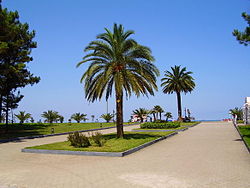
Much of western Georgia lies within the northern periphery of the humid subtropical zone with annual precipitation ranging from 1,000–4,000 mm (39.4–157.5 in). The precipitation tends to be uniformly distributed throughout the year, although the rainfall can be particularly heavy during the Autumn months. The climate of the region varies significantly with elevation and while much of the lowland areas of western Georgia are relatively warm throughout the year, the foothills and mountainous areas (including both the Greater and Lesser Caucasus Mountains) experience cool, wet summers and snowy winters (snow cover often exceeds 2 meters in many regions). Ajaria is the wettest region of the Caucasus, where the Mt. Mtirala rainforest, east of Kobuleti receives around 4,500 mm (177.2 in) of precipitation per year.
Eastern Georgia has a transitional climate from humid subtropical to continental. The region's weather patterns are influenced both by dry, Caspian air masses from the east and humid, Black Sea air masses from the west. The penetration of humid air masses from the Black Sea is often blocked by several mountain ranges ( Likhi and Meskheti) that separate the eastern and western parts of the nation. Annual precipitation is considerably less than that of western Georgia and ranges from 400–1,600 mm (15.7–63.0 in).
The wettest periods generally occur during Spring and Autumn while Winter and the Summer months tend to be the driest. Much of eastern Georgia experiences hot summers (especially in the low-lying areas) and relatively cold winters. As in the western parts of the nation, elevation plays an important role in eastern Georgia where climatic conditions above 1,500 metres (4,921 ft) are considerably colder than in the low-lying areas. The regions that lie above 2,000 metres (6,562 ft) frequently experience frost even during the summer months.
Biodiversity
Because of its high landscape diversity and low latitude Georgia is home to about 1000 species of vertebrates, (330 birds, 160 fish, 48 reptiles, and 11 amphibians). A number of large carnivores live in the forests, namely Brown bears, wolves and lynxes. The common pheasant (also known as the Colchian Pheasant) is an endemic bird of Georgia which has been widely introduced throughout the rest of the world as an important game bird. The species number of invertebrates is considered to be very high but data is distributed across a high number of publications. The spider checklist of Georgia, for example, includes 501 species.
Just over 6500 species of fungi, including lichen-forming species, have been recorded from Georgia, but this number is far from complete. The true total number of fungal species occurring in Georgia, including species not yet recorded, is likely to be far higher, given the generally accepted estimate that only about 7% of all fungi worldwide have so far been discovered. Although the amount of available information is still very small, a first effort has been made to estimate the number of fungal species endemic to Georgia, and 2595 species have been tentatively identified as possible endemics of the country. 1729 species of plants have been recorded from Georgia in association with fungi. The true number of plant species occurring in Georgia is likely to be substantially higher.
Regions
| Regions of Georgia | ||
|---|---|---|
| Map ref. | Region | Capital |
| 1 | Abkhazia | Sukhumi (Sokhumi) |
| 2 | Samegrelo-Zemo Svaneti | Zugdidi |
| 3 | Guria | Ozurgeti |
| 4 | Adjara | Batumi |
| 5 | Racha-Lechkhumi and Kvemo Svaneti |
Ambrolauri |
| 6 | Imereti | Kutaisi |
| 7 | Samtskhe-Javakheti | Akhaltsikhe |
| 8 | Shida Kartli | Gori |
| 9 | Mtskheta-Mtianeti | Mtskheta |
| 10 | Kvemo Kartli | Rustavi |
| 11 | Kakheti | Telavi |
| 12 | Tbilisi | Tbilisi |
Georgia is divided into 9 regions, 1 city, and 2 autonomous republics. These in turn are subdivided into 69 districts.
Autonomous republics
Georgia contains two official autonomous regions, of which one has declared independence. In addition, another territory not officially autonomous has also declared independence. Officially autonomous within Georgia, the de facto independent region of Abkhazia declared independence in 1999. The de facto independent South Ossetia is officially known within Georgia as the Tskinvali region to separate it from the Russian North Ossetia. It was autonomous under the Soviet Union, and when it was renamed to Tskinvali in 1995 its autonomy was removed. De facto separate since Georgian independence, offers were made to give South Ossetia autonomy again, but in 2006 an unrecognised referendum in the area resulted in a vote for independence.
In both territories large numbers of people had been given Russian passports, some through a process of forced passportization by Russian authorities. This was used as a justification for Russian invasion of Georgia during the 2008 South Ossetia war after which Russia recognised the region's independence. Independence is denied by Georgia, which considers the regions as occupied by Russia. Both republics have received minimal international recognition.
Adjara gained autonomy unilaterally under local strongman Aslan Abashidze, who maintained close ties with Russia and allowed a Russian military base to be built in Batumi. Upon the election of Mikheil Saakashvili in 2004 tensions rose between Adjara and the Georgian government, leading to demonstrations in Adjara and the resignation and fleeing of Abashidze. The region retains autonomy.
Government and politics
Georgia is a democratic semi-presidential republic, with the President as the head of state, and Prime Minister as the head of government. The executive branch of power is made up of the President and the Cabinet of Georgia. The Cabinet is composed of ministers, headed by the Prime Minister, and appointed by the President. Notably, the ministers of defense and interior are not members of the Cabinet and are subordinated directly to the President of Georgia. Mikheil Saakashvili is the current President of Georgia after winning 53.47% of the vote in the 2008 election. Since 2012 Bidzina Ivanishvili has been the prime minister of Georgia.
Legislative authority is vested in the Parliament of Georgia. It is unicameral and has 150 members, known as deputies, from which 75 members are proportional representatives and 75 are elected through single-member district plurality system, representing their constituencies. Members of parliament are elected for four-year terms. Five parties and electoral blocs had representatives elected to the parliament in the 2008 elections: the United National Movement (governing party), The Joint Opposition, the Christian-Democrats, the Labour Party and Republican Party. On 26 May 2012, Saakashvili inaugurated a new Parliament building in the western city of Kutaisi, in an effort to decentralise power and shift some political control closer to Abkhazia.
Although considerable progress was made since the Rose revolution, Saakashvili states that Georgia is still not a "full-fledged, very well-formed, crystalized society." The political system remains in the process of transition, with frequent adjustments to the balance of power between the President and Parliament, and opposition proposals ranging from transforming the country into parliamentary republic to re-establishing the monarchy. Observers note the deficit of trust in relations between the Government and the opposition.
Different opinions exist regarding the degree of political freedom in Georgia. President Saakashvili believes that the country is "on the road to becoming a European democracy." Freedom House lists Georgia as a partly free country.
In preparation for 2012 parliamentary elections, Parliament adopted a new electoral code on December 27, 2011 that incorporated many recommendations from non-governmental organizations (NGOs) and the Venice Commission. However, the new code failed to address the Venice Commission’s primary recommendation to strengthen the equality of the vote by reconstituting single-mandate election districts to be comparable in size. On December 28, Parliament amended the Law on Political Unions to regulate campaign and political party financing. Local and international observers raised concerns about several amendments, including the vagueness of the criteria for determining political bribery and which individuals and organizations would be subject to the law. As of March 2012, Parliament was discussing further amendments to address these concerns.
The elections in October 2012 resulted in the clear victory for the opposition, which President Saakashvili conceded on the following day.
Human rights
Human rights in Georgia are guaranteed by the country's constitution. There is an independent human rights public defender elected by the Parliament of Georgia to ensure such rights are enforced. Georgia has ratified the Framework Convention for the Protection of National Minorities in 2005. NGO "Tolerance", in its alternative report about its implementation, speaks of rapid decreasing of the number of Azerbaijani schools and cases of appointing headmasters to Azerbaijani schools who don't speak the Azerbaijani language.
The government came under criticism for its alleged use of excessive force on May 26, 2011 when it dispersed protesters led by Nino Burjanadze, among others, with tear gas and rubber bullets after they refused to clear Rustaveli avenue for an independence day parade despite the expiration of their demonstration permit and despite being offered to choose an alternative venue. While human rights activists maintained that the protests were peaceful, the government pointed out that many protesters were masked and armed with heavy sticks and molotov cocktails. Georgian opposition leader Nino Burjanadze said the accusations of planning a coup were baseless, and that the protesters' actions were legitimate.
Foreign relations

Georgia maintains good relations with its direct neighbours Armenia, Azerbaijan, Turkey, and is a member of the United Nations, the Council of Europe, the World Trade Organization, the Organization of the Black Sea Economic Cooperation, the Organization for Security and Cooperation in Europe, the Community of Democratic Choice, the GUAM Organization for Democracy and Economic Development, and the Asian Development Bank. Georgia also maintains political, economic and military relations with Japan, Uruguay, South Korea, Israel, Sri Lanka Ukraine and many other countries.
The growing U.S. and European Union influence in Georgia, notably through proposed EU and NATO membership, the U.S. Train and Equip military assistance program and the construction of the Baku-Tbilisi-Ceyhan pipeline, have frequently strained Tbilisi's relations with Moscow. Georgia's decision to boost its presence in the coalition forces in Iraq was an important initiative.
Georgia is currently working to become a full member of NATO. In August 2004, the Individual Partnership Action Plan of Georgia was submitted officially to NATO. On October 29, 2004, the North Atlantic Council of NATO approved the Individual Partnership Action Plan (IPAP) of Georgia and Georgia moved on to the second stage of Euro-Atlantic Integration. In 2005, by the decision of the President of Georgia, a state commission was set up to implement the Individual Partnership Action Plan, which presents an interdepartmental group headed by the Prime Minister. The Commission was tasked with coordinating and controlling the implementation of the Individual Partnership Action Plan.
On February 14, 2005, the agreement on the appointment of Partnership for Peace (PfP) liaison officer between Georgia and NATO came into force, whereby a liaison officer for the South Caucasus was assigned to Georgia. On March 2, 2005, the agreement was signed on the provision of the host nation support to and transit of NATO forces and NATO personnel. On March 6–9, 2006, the IPAP implementation interim assessment team arrived in Tbilisi. On April 13, 2006, the discussion of the assessment report on implementation of the Individual Partnership Action Plan was held at NATO Headquarters, within 26+1 format. In 2006, the Georgian parliament voted unanimously for the bill which calls for integration of Georgia into NATO. The majority of Georgians and politicians in Georgia support the push for NATO membership.
From the European commission website: President Saakashvili views membership of the EU and NATO as a long term priority. As he does not want Georgia to become an arena of Russia-U.S. confrontation he seeks to maintain close relations with the United States and European Union, at the same time underlining his ambitions to advance co-operation with Russia. George W. Bush became the first sitting U.S. president to visit the country. The street leading to Tbilisi International Airport has since been dubbed George W. Bush Avenue. On October 2, 2006, Georgian and the European Union signed a joint statement on the agreed text of the Georgia-European Union Action Plan within the European Neighbourhood Policy (ENP). The Action Plan was formally approved at the EU-Georgia Cooperation Council session on November 14, 2006 in Brussels.
Military
Georgia's military is organized into land and air forces. They are collectively known as the Georgian Armed Forces (GAF). The mission and functions of the GAF are based on the Constitution of Georgia, Georgia’s Law on Defense and National Military Strategy, and international agreements to which Georgia is signatory. They are performed under the guidance and authority of the Ministry of Defense.
Since coming to power in 2004, Saakashvili has boosted spending on the country's armed forces and increased its overall size to around 45,000. Of that figure, 12,000 have been trained in advanced techniques by US military instructors, under the Georgia Train and Equip Program. Some of these troops have been stationed in Iraq as part of the international coalition in the region, serving in Baqubah and the Green Zone of Baghdad.
In May 2005, the 13th "Shavnabada" Light Infantry Battalion became the first full battalion to serve outside of Georgia. This unit was responsible for two checkpoints to the Green Zone, and provided security for the Iraqi Parliament. In October 2005, the unit was replaced by the 21st Infantry Battalion. Soldiers of the 13th "Shavnabada" Light Infantry Battalion wear the "combat patches" of the American unit they served under, the Third Infantry Division.
Since 2009, Georgia contributes nearly 1000 soldiers to the NATO-led International Security Assistance Force in Afghanistan, making it the highest per-capita troop contributor to the mission. As of September 2011, Georgia has suffered 10 deaths and 38 injuries.
Law enforcement
In Georgia, law enforcement is conducted and provided for by the Ministry of Internal Affairs of Georgia. In recent years, the Patrol Police Department of the Ministry of Internal Affairs of Georgia has undergone a radical transformation, with the police having now absorbed a great many duties previously performed by dedicated independent government agencies. New duties performed by the police include border security and customs functions and contracted security provision; the latter function is performed by the dedicated 'security police'. Intelligence collecting in the interests of national security is now the remit of the Georgian Intelligence Service.
In 2005 President Mikhail Saakashvili fired the entire traffic police force (numbering around 30,000 police officers) of the Georgian National Police due to corruption. A new force was then subsequently built around new recruits. The US State Department's Bureau of International Narcotics and Law-Enforcement Affairs has provided assistance to the training efforts and continues to act in an advisory capacity.
The new 'Patruli' force was first introduced in the summer of 2005 to replace the traffic police, a force which was accused of widespread corruption. The police introduced an 022 emergency dispatch service in 2004.
Since the restructuring announced in 2005 almost all of Georgia's internal security agencies have acquired large amounts of new equipment and staff. One of the most visible changes that has come about as a result of the police force's restructuring and re-equipment is arguably the new liveries applied to service vehicles and uniforms for personnel; in both cases the Police has tried to move away from traditional designs and instead use modern hard-wearing materials and proven utilitarian, modern design.
Economy

Archaeological research demonstrates that Georgia has been involved in commerce with many lands and empires since the ancient times, largely due its location on the Black Sea and later on the historical Silk Road. Gold, silver, copper and iron have been mined in the Caucasus Mountains. Wine making is a very old tradition. The country has sizable hydropower resources. Throughout Georgia's modern history agriculture and tourism have been principal economic sectors, because of the country's climate and topography.
For much of the 20th century, Georgia's economy was within the Soviet model of command economy. Since the fall of the USSR in 1991, Georgia embarked on a major structural reform designed to transition to a free market economy. As with all other post-Soviet states, Georgia faced a severe economic collapse. The civil war and military conflicts in South Ossetia and Abkhazia aggravated the crisis. The agriculture and industry output diminished. By 1994 the gross domestic product had shrunk to a quarter of that of 1989. The first financial help from the West came in 1995, when the World Bank and International Monetary Fund granted Georgia a credit of USD 206 million and Germany granted DM 50 million.
Since the early 21st century visible positive developments have been observed in the economy of Georgia. In 2007 Georgia's real GDP growth rate reached 12%, making Georgia one of the fastest growing economies in Eastern Europe. The World Bank dubbed Georgia "the number one economic reformer in the world" because it has in one year improved from rank 112th to 18th in terms of ease of doing business. The country has a high unemployment rate of 12.6% and has fairly low median income compared to European countries.
The 2006 ban on imports of Georgian wine to Russia, one of Georgia's biggest trading partners, and break of financial links was described by the IMF Mission as an "external shock", In addition, Russia increased the price of gas for Georgia. This was followed by the spike in the Georgian lari's rate of inflation. The National Bank of Georgia stated that the inflation was mainly triggered by external reasons, including Russia’s economic embargo. The Georgian authorities expected that the current account deficit due to the embargo in 2007 would be financed by "higher foreign exchange proceeds generated by the large inflow of foreign direct investment" and an increase in tourist revenues. The country has also maintained a solid credit in international market securities. Georgia is becoming more integrated into the global trading network: its 2006 imports and exports account for 10% and 18% of GDP respectively. Georgia's main imports are natural gas, oil products, machinery and parts, and transport equipment.
Tourism is an increasingly significant part of the Georgian economy. About a million tourists brought US$313 million to the country in 2006. According to the government, there are 103 resorts in different climatic zones in Georgia. Tourist attractions include more than 2000 mineral springs, over 12,000 historical and cultural monuments, four of which are recognised as UNESCO World Heritage Sites ( Bagrati Cathedral in Kutaisi and Gelati Monastery, historical monuments of Mtskheta, and Upper Svaneti).
Georgia is developing into an international transport corridor through Batumi and Poti ports, an oil pipeline from Baku through Tbilisi to Ceyhan, the Baku-Tbilisi-Ceyhan pipeline (BTC) and a parallel gas pipeline, the South Caucasus Pipeline.
Since coming to power Saakashvili administration accomplished a series of reforms aimed at improving tax collection. Among other things a flat income tax was introduced in 2004. As a result budget revenues have increased fourfold and a once large budget deficit has turned into surplus.
As of 2001 54% of the population lived below the national poverty line but by 2006 poverty decreased to 34%. In 2005 average monthly income of a household was GEL 347 (about 200 USD). IMF 2007 estimates place Georgia's nominal GDP at US$10.3 billion. Georgia's economy is becoming more devoted to services (now representing 65% of GDP), moving away from agricultural sector ( 10.9%).
Transport
Today transport in Georgia is provided by means of rail, road, shipping and air travel. Positioned in the Caucasus and on the coast of the Black Sea, Georgia is a key country through which energy imports to the European Union from neighbouring Azerbaijan pass. Traditionally the country was located on an important north-south trade route between European Russia and the Near East and Turkey.
In recent years Georgia has invested large amounts of money in the modernisation of its transport networks. The construction of new highways has been prioritised and, as such, major cities like Tbilisi have seen the quality of their roads improve dramatically; despite this however, the quality of inter-city routes remains poor and to date only one motorway-standard road has been constructed - the ს 1.
The Georgian railways represent an important transport artery for the Caucasus as they make up the largest proportion of a route linking the Black and Caspian Seas, this in turn has allowed them to benefit in recent years from increased energy exports from neighbouring Azerbaijan to the European Union, Ukraine and Turkey. Passenger services are operated by the state-owned Georgian Railways whilst freight operations are carried out by a number of licensed operators. Since 2004 the Georgian Railways have been undergoing a rolling program of fleet-renewal and managerial restructuring which is aimed at making the service provided more efficient and comfortable for passengers. Infrastructural development has also been high on the agenda for the railways, with the key Tbilisi railway junction expected to undergo major reorganisation in the near future. Additional projects also include the construction of the economically important Kars–Tbilisi–Baku railway, which for the first time will connect much of the Caucasus with Turkey by standard gauge railway.
Air and maritime transport is developing in Georgia, with the former mainly used by passengers and the latter for transport of freight. Georgia currently has four international airports; the largest of which is by far Tbilisi International Airport, hub for Georgian Airways, which offers connections to many large European cities. Other airports in the country are largely underdeveloped or lack scheduled traffic, although, as of late, efforts have been made to solve both these problems. There are a number of seaports along Georgia's Black Sea coast, the largest and must busy of which is the Port of Batumi; whilst the town is itself a seaside resort, the port is a major cargo terminal in the caucasus and is often used by neighbouring Azerbaijan as a transit point for making energy deliveries to Europe. Scheduled and chartered passenger ferry services link Georgia with Ukraine and Turkey.
Demographics
Like most native Caucasian peoples, the Georgians do not fit into any of the main ethnic categories of Europe or Asia. The Georgian language, the most pervasive of the Kartvelian languages, is neither Indo-European, Turkic nor Semitic. The present day Georgian or Kartvelian nation is thought to have resulted from the fusion of aboriginal, autochthonous inhabitants with immigrants who infiltrated into South Caucasus from the direction of Anatolia in remote antiquity. The ancient Jewish chronicle by Josephus mentions Georgians as Iberes who were also called Thobel Tubal.
Ethnic Georgians form about 84% of Georgia's current population of 4,661,473 (July 2006 est.). Other ethnic groups include Abkhazians, Armenians, Azeris, Belorusians, Bulgarians, Estonians, Germans, Greeks, Jews, Moldovans, Ossetians, Poles, Russians, Turks and Ukrainians. Georgia's Jewish community is one of the oldest Jewish communities in the world. 2012 saw a 60% increase in the number of Iranian immigrants to Georgia, bringing the total in the country to an estimated 100,000 by the end of that year.
The most widespread language group is the Kartvelian family, which includes Georgian, Svan, Mingrelian and Laz. The official languages of Georgia are Georgian, with Abkhaz official within the autonomous region of Abkhazia. Georgian is the primary language of approximately 71% of the population, followed by 9% speaking Russian, 7% Armenian, 6% Azeri, and 7% other languages.
In the early 1990s, following the dissolution of the Soviet Union, violent separatist conflicts broke out in the autonomous regions of Abkhazia and South Ossetia. Many Ossetians living in Georgia left the country, mainly to Russia's North Ossetia. On the other hand, more than 150,000 Georgians left Abkhazia after the breakout of hostilities in 1993. Of the Meskhetian Turks who were forcibly relocated in 1944 only a tiny fraction returned to Georgia as of 2008.
The 1989 census recorded 341,000 ethnic Russians, or 6.3% of the population, 52,000 Ukrainians and 100,000 Greeks in Georgia. Since 1990, 1.5 million Georgian nationals have left. At least one million immigrants from Georgia legally or illegally reside in Russia. Georgia's net migration rate is −4.54, excluding Georgian nationals who live abroad. Georgia has nonetheless been inhabited by immigrants from all over the world throughout its independence. According to 2006 statistics, Georgia gets most of its immigrants from Turkey and China.
Today 83.9% of the population practices Eastern Orthodox Christianity, with majority of these adhering to the national Georgian Orthodox Church. Religious minorities include Muslims (9.9%), Armenian Apostolic (3.9%), and Roman Catholic (0.8%). 0.8% of those recorded in the 2002 census declared themselves to be adherents of other religions and 0.7% declared no religion at all.
| Largest cities or towns of Georgia National Statistics Office of Georgia - Population report (2012) |
|||||||||
|---|---|---|---|---|---|---|---|---|---|
| Rank | City name | Georgia|Administrative division | Pop. | ||||||
 Tbilisi |
1 | Tbilisi | Tbilisi | 1,172,700 |  Batumi |
||||
| 2 | Kutaisi | Imereti | 196,800 | ||||||
| 3 | Batumi | Adjara | 125,800 | ||||||
| 4 | Rustavi | Kvemo Kartli | 122,500 | ||||||
| 5 | Zugdidi | Samegrelo-Zemo Svaneti | 75,700 | ||||||
| 6 | Gori | Shida Kartli | 54,900 | ||||||
| 7 | Poti | Samegrelo-Zemo Svaneti | 47,900 | ||||||
| 8 | Sukhumi | Abkhazia | 39,100 | ||||||
| 9 | Khashuri | Shida Kartli | 38,700 | ||||||
| 10 | Samtredia | Imereti | 32,200 | ||||||
Religion
A large majority of Georgia's population (83.9% in 2002) practices Orthodox Christianity. The Georgian Orthodox Church is one of the world's most ancient Christian Churches, and claims apostolic foundation by Saint Andrew. In the first half of the 4th century Christianity was adopted as the state religion of Iberia (present-day Kartli, or Eastern Georgia), following the missionary work of Saint Nino of Cappadocia. The Church gained autocephaly during the early Middle Ages; it was abolished during the Russian domination of the country, restored in 1917 and fully recognised by the Ecumenical Patriarchate of Constantinople in 1990.
Despite the rise of religiosity in the country since the Soviet collapse, 68% of the Georgian population does not regularly attend religious services, which reflects the fact that many Georgians nominally identify with Orthodox Christianity for traditional, cultural and historical reasons. Additionally, an estimated quarter of the population believes that religion does not hold an important place in their life.
Religious minorities of Georgia include Armenian Christians (3.9%), Muslims (9.9%), and Roman Catholics (0.8%). Islam is disproportionately represented by Azerbaijani Shia Muslims in the south east, with some ethnic Georgian Sunni Muslims in Adjara. Georgian Jews trace the history of their community to the 6th century BC; their numbers have dwindled in the last decades due to strong emigration towards Israel.
Despite the long history of religious harmony in Georgia, there have been several instances of religious discrimination and violence against "nontraditional faiths", such as Jehovah's Witnesses, by the followers of the defrocked Orthodox priest Vasil Mkalavishvili.
Education
The education system of Georgia has undergone sweeping modernizing, although controversial, reforms since 2004. Education in Georgia is mandatory for all children aged 6–14. The school system is divided into elementary (6 years; age level 6–12), basic (3 years; age level 12–15), and secondary (3 years; age level 15–18), or alternatively vocational studies (2 years). Students with a secondary school certificate have access to higher education. Only the students who have passed the Unified National Examinations may enroll in a state-accredited higher education institution, based on ranking of scores he/she received at the exams.
Most of these institutions offer three levels of study: a Bachelor's Program (3–4 years); a Master's Program (2 years), and a Doctoral Program (3 years). There is also a Certified Specialist's Program that represents a single-level higher education program lasting for 3–6 years. As of 2008, 20 higher education institutions are accredited by the Ministry of Education and Science of Georgia. Gross primary enrollment ratio was 94% for the period of 2001–2006.
Culture
Georgian culture evolved over thousands of years with its foundations in Iberian and Colchian civilizations, continuing into the rise of the unified Georgian Kingdom under the single monarchy of the Bagrationi. Georgian culture enjoyed a golden age and renaissance of classical literature, arts, philosophy, architecture and science in the 11th century.
The Georgian language, and the Classical Georgian literature of the poet Shota Rustaveli, were revived in the 19th century after a long period of turmoil, laying the foundations of the romantics and novelists of the modern era such as Grigol Orbeliani, Nikoloz Baratashvili, Ilia Chavchavadze, Akaki Tsereteli, Vazha Pshavela, and many others. Georgian culture was influenced by Classical Greece, the Roman Empire, the Byzantine Empire, and later by the Russian Empire.
Georgians have their own unique 3 alphabets which according to traditional accounts was invented by King Pharnavaz I of Iberia in 3rd century BC.
Georgia is well known for its rich folklore, unique traditional music, theatre, cinema, and art. Georgians are renowned for their love of music, dance, theatre and cinema. In the 20th century there have been notable Georgian painters such as Niko Pirosmani, Lado Gudiashvili, Elene Akhvlediani; ballet choreographers such as George Balanchine, Vakhtang Chabukiani, and Nino Ananiashvili; poets such as Galaktion Tabidze, Lado Asatiani, and Mukhran Machavariani; and theatre and film directors such as Robert Sturua, Tengiz Abuladze, Giorgi Danelia and Otar Ioseliani.
Architecture and arts
Georgian architecture has been influenced by many civilizations. There are several different architectural styles for castles, towers, fortifications and churches. The Upper Svaneti fortifications, and the castle town of Shatili in Khevsureti, are some of the finest examples of medieval Georgian castle architecture. Other architectural aspects of Georgia include Rustaveli avenue in Tbilisi in the Hausmann style, and the Old Town District.
Georgian ecclesiastic art is one of the most fascinating aspects of Georgian Christian architecture, which combines classical dome style with original basilica style forming what is known as the Georgian cross-dome style. Cross-dome architecture developed in Georgia during the 9th century; before that, most Georgian churches were basilicas. Other examples of Georgian ecclesiastic architecture can be found outside Georgia: Bachkovo Monastery in Bulgaria (built in 1083 by the Georgian military commander Grigorii Bakuriani), Iviron monastery in Greece (built by Georgians in the 10th century), and the Monastery of the Cross in Jerusalem (built by Georgians in the 9th century).
The art of Georgia spans the prehistoric, the ancient Greek, Roman, medieval, ecclesiastic, iconic and modern visual arts. One of the most famous late 19th/early 20th century Georgian artists is a primitivist painter Niko Pirosmani.
Music
Georgia has a rich and vibrant musical tradition, primarily known for its early development of polyphony. Georgian polyphony is based on three vocal parts, a unique tuning system based on perfect fifths, and a harmonic structure rich in parallel fifths and dissonances. Each region in Georgia has its own traditional music with Persian influenced drones and ostinato-like soloists in the East, complex improvised harmonies in the west, and solid moving chords in Svanetie.
Cuisine

Georgian cuisine and wine have evolved through the centuries, adapting traditions in each era. One of the most unusual traditions of dining is Supra, or Georgian table, which is also a way of socialising with friends and family. The head of Supra is known as Tamada. He also conducts the highly philosophical toasts, and makes sure that everyone is enjoying themselves. Various historical regions of Georgia are known for their particular dishes: for example, Khinkali (meat dumplings), from eastern mountainous Georgia, and Khachapuri, mainly from Imereti, Samegrelo and Adjara. In addition to traditional Georgian dishes, the foods of other countries have been brought to Georgia by immigrants from Russia, Greece, and recently China.
Sports

The most popular sports in Georgia are football, basketball, rugby union, wrestling, judo, and weightlifting. Historically, Georgia has been famous for its physical education; it is known that the Romans were fascinated with Georgians' physical qualities after seeing the training techniques of ancient Iberia. Wrestling remains a historically important sport of Georgia, and some historians think that the Greco-Roman style of wrestling incorporates many Georgian elements.
Within Georgia, one of the most popularized styles of wrestling is the Kakhetian style. There were a number of other styles in the past that are not as widely used today. For example, the Khevsureti region of Georgia has three different styles of wrestling. Other popular sports in 19th century Georgia were polo, and Lelo, a traditional Georgian game later replaced by rugby union.
The first and only race circuit in the Caucasian region is located in Georgia. Rustavi International Motorpark originally built in 1978 was re-opened in 2012 after total reconstruction costing $20 million. The track satisfies the FIA Grade 2 requirements and currently hosts the Legends car racing series and Formula Alfa competitions.


